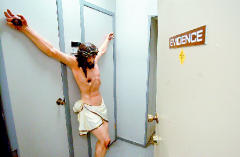

Sunday, 11 December 2004
On 31 August, U.S. Border Patrol agents near Eagle Pass, Texas, found a life-sized crucifix, minus the cross, on a sandbar in the middle of the Rio Grande. The agents dragged the statue to shore and took it to the Eagle Pass police station, where it remained while the city waited to see if anyone would claim it. No one did, so last week the city decided to donate the statue to Our Lady of Refuge Catholic Church.
Since its discovery, the image of Jesus has attracted the curious and the faithful from the local area and from across the two countries. At least 3,200 people have visited the statue so far. Bishop James A. Tamayo of Laredo accepted the statue on behalf of the diocese of Laredo (which includes Eagle Pass), stating that the statue would be housed in a new chapel and open daily for public viewing. The origin of the statue and the disposition of the missing cross remain mysteries, but they have only added to the interest generated.
The statue itself is fairly unremarkable, but the name that has come to be associated with it speaks volumes. Many are calling it the Jesus Christ of the Undocumented. The statue is a symbol of the struggles that undocumented immigrants face when trying the reach El Norte, the Promised Land of the U.S.A. The statue's initial appearance in a sandbar in the middle of the Rio Grande (usually called the Rio Bravo by Mexicans) is reminiscent of many immigrants' path to the U.S. across the river into Texas. It is reminiscent as well of the Israelites' crossing of the Jordan River into the land of Canaan under the leadership of Joshua. In both cases weary travelers were anxious to enter a land rumored to be filled with incredible bounty and opportunity. Also in both cases many pilgrims were disappointed by the rigors of life and obstacles on the other side.
The travails of the statue also elicit images of the suffering that many undocumented travelers face. Some drown in the occasional torrents of the Rio Grande, trying to get to Texas. Others die of thirst in the deserts of Arizona and New Mexico. Some make it safely into the U.S. only to find themselves slaves in garment factories or other sweatshops or, even worse, forced into lives of prostitution. Others are packed into container trucks and abandoned to suffocate in heat greater than 40 degrees Celsius (temperatures well over 100 degrees Fahrenheit). Still others are turned back at the border and never make it very far into the U.S. A few do make it, however, and the rewards are sometimes great. Undocumented immigrants tend to live very frugally, and they send a good portion of the money they make to support relatives still at home or trying to come to the U.S. as well.
Finally, Jesus Christ of the Undocumented reminds Christians that Jesus suffers the indignities of the undocumented as they struggle, suffer, and sometimes die in their attempts to reach El Norte. Jesus said, "Inasmuch as you've done it to the least of these, my brothers and sisters, you've done it unto me." How do we Christians in the U.S. treat the undocumented? Do we complain about "their" presence among "us"? Do we call them by the derisive term "wetbacks"? Do we take advantage of their willingness to work cheaply and pay them substandard wages for work around our houses? Do we support politicians and policies that make their lives more difficult than they already are, for example, by prohibiting them from getting driver's licenses or preventing their children from attending public schools? When we persecute the undocumented in these and other ways, we are driving nails into the hands of Jesus himself, as the bleeding hands and brow of Jesus Christ of the Undocumented reminds us. On the other hand, when we offer friendship, food, housing, fair-paying jobs, education, health care, and basic human rights to the undocumented, and when we support legislation such as the DREAM Act, we are showing love to Jesus himself, and we will be rewarded for being faithful to God.
The undocumented, whether moving north through Central America and Mexico, massing on the Mexico-U.S. border, or already in the U.S., carry in their bodies the image of Christ. They are our brothers and sisters who happen to have been born south of an arbitrary political line that follows the Rio Grande, then the thirty-first parallel, then bends northwest to the southern border of California. They are worthy of our compassion, our help, our prayers, and our tangible support. The image of Jesus Christ of the Undocumented is sheltered in the church of Our Lady of Refuge. Can the undocumented who carry the image of Jesus Christ in their bodies turn to us for refuge?